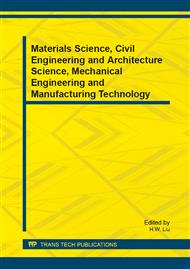[1]
L.L. MISHNAEVSKY JR, Physical Mechanisms of Hard Rock Fragmentation under Mechanical Loading: A Review. Int. J. Rock Mech. Min. Sci. & Geomech. Abstr. Vol. 32, No. 8, 1995, pp.763-766.
DOI: 10.1016/0148-9062(95)00027-e
Google Scholar
[2]
H.Y. Liu, S.Q. Kou and P.A. Lindqvist. Numerical simulation of the rock fragmentation process induced by indenters. International Journal of Rock Mechanics & Mining Sciences, Vol. 39, 2002, p.491–505.
DOI: 10.1016/s1365-1609(02)00043-6
Google Scholar
[3]
H.Y. Liu, S.Q. Kou and P.A. Lindqvist. Numerical Studies on Bit-Rock Fragmentation Mechanisms. International Journal of Geo-mechanics ASCE, Vol. 8, No. 1, 2008, pp.45-67.
Google Scholar
[4]
Y. Ahna, T.N. Farris and S. Chandrasekar. Sliding micro indentation fracture of brittle materials: Role of elastic stress fields. Mechanics of Materials, Vol. 29, 1998, pp.143-152.
DOI: 10.1016/s0167-6636(98)00012-x
Google Scholar
[5]
S.Q. Kou, H.Y. Liu, P.A. Lindqvist and C.A. Tang. Rock fragmentation mechanisms induced by a drill bit. Int. J. Rock Mech. Min. Sci, Vol. 41, 2004, p.527–532.
DOI: 10.1016/j.ijrmms.2004.03.094
Google Scholar
[6]
Y. Ahn and N.G. Cho. Lateral Crack in Abrasive Wear of Brittle Materials. JSMS international Journal, Vol. 46, No. 2, 2010, pp.140-144.
Google Scholar
[7]
B.R. Lawn and M.V. Swain. Microfracture beneath point indentations in brittle solids. Journal of Materials Science, Vol. 10, 1975, pp.113-122.
DOI: 10.1007/bf00541038
Google Scholar
[8]
M.V. Swain and B.R. Lawn. Indentation fracture in brittle rocks and glasses. Int. J. Rock Mech. Min. Sci. Vol. 13, 1976, pp.311-319.
DOI: 10.1016/0148-9062(76)91830-1
Google Scholar
[9]
S. Li, Z. Shangguan and J. Wang. Computer simulation of sequential impoundment process of concrete-faced rockfill dam. Journal of Computer, Vol. 7, No. 8, 2012, p.1801–1808.
DOI: 10.4304/jcp.7.8.1801-1808
Google Scholar
[10]
H. Huang, B. Damjanac and E. Detournay. Normal Wedge Indentation in Rocks with Lateral Confinement. Rock Mech. Rock Engng. Vol. 31, No. 2, 1998, p.81–94.
DOI: 10.1007/s006030050010
Google Scholar
[11]
L.H. Chen and J.F. Labuz. Indentation of rock by wedge-shaped tools. Rock Mechanics and Mining Science, Vol. 43, 2006, pp.1023-1033.
DOI: 10.1016/j.ijrmms.2006.03.005
Google Scholar


